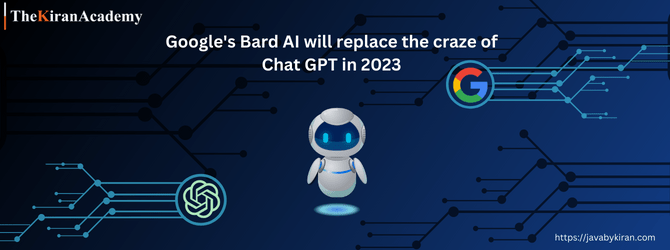In 2023, Google’s Bard AI will take the place of the Chat GPT craze. In recent past weeks, Google announced Bard, a language model for dialogue applications (LaMDA). Google stated that it would begin distributing the tool in the United States and the United Kingdom, with plans to make it available in additional languages and countries eventually.
Introduction
In light of ChatGPT’s recent viral success, tech companies like Google, Microsoft, Facebook, and others are rushing to create and implement AI-powered tools. Google announced last week that it would also incorporate AI into its productivity tools, such as Gmail, Sheets, and Docs. Microsoft announced a similar AI upgrade to its productivity tools shortly after.
Human-Like Reaction
A chatbot’s success depends on its ability to respond in a manner that resembles that of a real person. Bard outperforms ChatGPT-4 in terms of human-like responses, mimicking natural language, and having more open-ended conversations.
Technology Basis and Training Dataset
Google Bard and ChatGPT-4 both use transformer architectures, which process sequential input. We trained ChatGPT4 on an extensive dataset of text from the internet, including books, articles, and documents. While the Infiniset dataset was used for Bard’s training, Infiniset was specifically designed for discussions and dialogues. Thus, while both models can comprehend and generate text for multiple purposes, Bard has a more natural and open-ended conversation with humans.
Reliability of the Response
Establishing trust with clients relies on the authenticity of a chatbot’s responses. Even though Google claims that Bard’s responses are extremely genuine and closely resemble human speech, we discovered that some of its responses were less than genuine. For instance, it mentioned a tool called BlenderBot 4.0 when we asked it to list the top ten developments in generative AI in the last 24 hours. Versifier said that the instrument which is accessible to general society, can “create reasonable text and discourse that is unclear from human-produced content”.
Role of Python in Google & AI Technology
As far as a large amount of data is concerned, the human mind is capable of that; however, when it comes to processing, and absorbing it all at once, we failed. And that’s where the role of AI comes into the life. Learning Python Language to bring AI projects to life is mandatory. Google has used lots of features offered by Python Programming Language and now it’s time for AI.
Let’s highlight the reasons why Python is used in the AI process.
- Python’s library ecosystem
- Flexibility
- Platform independence
- Readability
- Good visualization options
- Community support
- Growing popularity
Check out the next Batch Schedule to start a career in AI- IT
Web Accessibility
Access to the internet is one of the main distinctions between ChatGPT-4 and Google Bard. Bard can attract its reactions from the web continuously, while ChatGPT4 depends on a dataset that just goes up until late 2021. Bard can provide the most recent research and answers to questions, whereas ChatGPT-4 may struggle to provide the most recent information due to this limitation. Additionally, every response from Bard includes a tiny Google Search icon. It suggests related queries that you can tap to Google for as you click on it.
User Experience and Interface
A chatbot’s accessibility to a wide range of users is dependent on its ease of use. When it comes to ease of use, Bard outperforms ChatGPT-4. It has text formatted in a way that is much simpler to scan and has an interface that looks better. Besides, Minstrel permits you to alter your inquiries after you pose to them. In addition, you can search for the response online and upvote or downvote it. Bard’s interface is more organized and clean overall.
Some of the Key Features of the Bard
- Accept voice input: Bard can be collaborated with utilizing your voice, which can be more advantageous in certain circumstances.
- Can generate varieties of formats: Text can be generated using Bard in a variety of formats, including HTML, Word, and PDF. This makes it simple to impart your work to other people or to involve it in different applications.
- Create web page summaries: Bard has the ability to summarize web pages, which is a great way to quickly comprehend a lengthy or complex article.
- Offer several drafts of its responses: Bard can give numerous drafts of its reactions, which is an extraordinary method for getting input on your work and ensuring that you come by the most ideal outcomes.
- Can describe code: Bard has the ability to explain code, which is a fantastic way to learn new programming languages or troubleshoot existing code.
- Recommend Google search: Bard can suggest further Google searches, which is a great way to learn more about a subject.
- Making trip plans: Bard can design your trip, which incorporates tracking down flights, inns, and exercises. You only need to tell Bard where you want to go and when, and he will make a travel plan for you.










